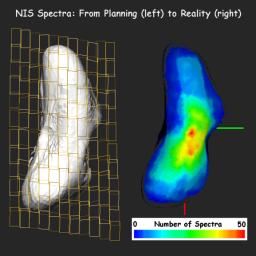
|
NEAR: From Planning to Data Analysis
- Click the image above for a larger view
- Full-Res JPEG (720 x 720) (70.0 kB)
- Full-Res TIFF (720 x 720) (318.6 kB)
Caption:
Planning and acquiring observations from NEAR's Near-Infrared Spectrometer (NIS) is a complex process that requires a detailed understanding of the strange shape and the rotational state of Eros. On February 13-14, 2000, just before insertion into Eros orbit, NEAR passed between Eros and the Sun. This geometry is called a low phase angle. It is optimum for spectroscopic observations, so at that time NIS obtained some of its most valuable data. To plan these activities in the preceding months, the NEAR science team developed a series of global NIS observation sequences like the one depicted in the left image. Here, NIS was instructed to scan its mirror back and forth across Eros while the spacecraft did a slow slew from top to bottom. The image shows the predicted coverage as viewed from directly over the north pole of a computerized "shape model" of Eros. Many such observation sequences were performed flawlessly on the spacecraft during the "low phase-angle flyby," and the highest-quality spectra were combined to show the resulting NIS coverage of Eros in the map on the right. The green and red regions show areas at high northern latitudes with the best coverage by NIS. Analysis of the NIS spectra is providing clues about the mineralogy and composition of Eros, and perhaps its early history and evolution.
Background Info:
Built and managed by The Johns Hopkins University Applied Physics Laboratory, Laurel, Maryland, NEAR was the first spacecraft launched in NASA's Discovery Program of low-cost, small-scale planetary missions. See the NEAR web page at http://near.jhuapl.edu/ for more details.
Cataloging Keywords:
| Name | Value | Additional Values |
|---|---|---|
| Target | 433 Eros | |
| System | Near Earth Objects | |
| Target Type | Asteroid | |
| Mission | NEAR Shoemaker | |
| Instrument Host | NEAR Shoemaker | |
| Host Type | Orbiter | |
| Instrument | Near-Infrared Spectrometer (NIS) | |
| Detector | ||
| Extra Keywords | Color, Infrared, Map, Rotation | |
| Acquisition Date | ||
| Release Date | 2000-06-10 | |
| Date in Caption | ||
| Image Credit | NASA/JPL/JHUAPL | |
| Source | photojournal.jpl.nasa.gov/catalog/PIA02489 | |
| Identifier | PIA02489 | |
